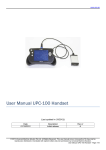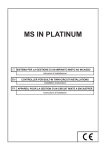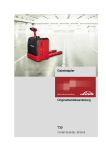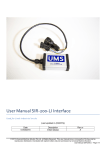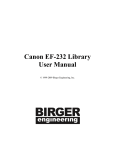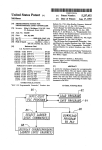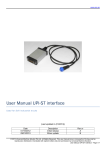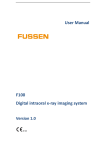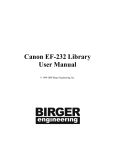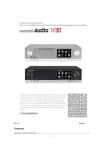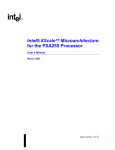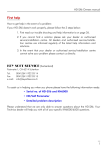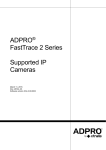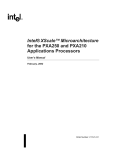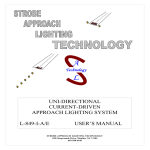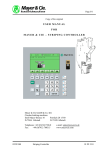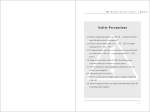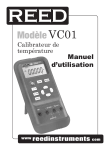Download User Manual UPI-200-LI interface
Transcript
www.ums.sg User Manual UPI-200-LI interface Used for Linde forklifts (Last update (2013/06/17)) Date Description 2013/06/16 First release Rev.nr © 2013 Universal Machine Solution Pte Ltd. All Rights Reserved. This user manual (one or more parts of it) may only be reproduced, distributed or translated with explicit written and prior permission by Universal Machine Solution. User manual UPI-200-LI Interface - Page 1/28 www.ums.sg Table of Contents 1 Introduction .................................................................................................................................................................3 1.1 Use .................................................................................................................................................................... 3 1.2 Warnings ........................................................................................................................................................... 3 1.3 Contents and first use ....................................................................................................................................... 3 2 Supported machines ..................................................................................................................................................4 3 Locating the service connector on the truck ..............................................................................................................6 3.1 Trucks with CANbus .......................................................................................................................................... 6 3.2 Trucks with OBD ............................................................................................................................................... 6 4 Starting up the UPC-100 handset ..............................................................................................................................6 5 Structure of the menu .................................................................................................................................................6 5.1 CANbus ............................................................................................................................................................. 6 5.1.1 Measurement (Zone D) ............................................................................................................................. 6 5.1.2 Setup (Zone E) .......................................................................................................................................... 7 5.1.3 Calibration (Zone F) .................................................................................................................................. 7 5.1.4 Logbook (Zone G) ..................................................................................................................................... 7 5.1.5 Console (Zone I) ........................................................................................................................................ 7 5.2 OBD ................................................................................................................................................................... 7 5.2.1 Terminal (Zone D) ..................................................................................................................................... 7 5.2.2 Reset service hours (Zone E) ................................................................................................................... 7 5.2.3 Console (Zone I) ........................................................................................................................................ 7 6 Cleaning the device ....................................................................................................................................................7 7 Maintenance ...............................................................................................................................................................7 8 Storage .......................................................................................................................................................................7 9 Problem solving ..........................................................................................................................................................8 10 Transport ....................................................................................................................................................................8 11 Regulatory compliance ...............................................................................................................................................8 12 Warranty .....................................................................................................................................................................8 13 Addendum ..................................................................................................................................................................9 13.1 Tilt angle sensor calibration procedure for Linde BR391 trucks ....................................................................... 9 13.2 Tilt angle sensor calibration procedure for Linde BR392 trucks ..................................................................... 13 13.3 Tilt angle sensor calibration procedure for Linde BR393 trucks ..................................................................... 18 13.4 Tilt angle sensor calibration procedure for Linde BR394 trucks ..................................................................... 23 13.5 Tiller foot poti setup for Linde BR1152 trucks ................................................................................................. 27 13.6 Speed reduction according to position of handlebar (tiller) for Linde BR1190 trucks ..................................... 28 © 2013 Universal Machine Solution Pte Ltd. All Rights Reserved. This user manual (one or more parts of it) may only be reproduced, distributed or translated with explicit written and prior permission by Universal Machine Solution. User manual UPI-200-LI Interface - Page 2/28 www.ums.sg 1 Introduction 1.1 Use The UPI-200-LI Interface and the UPC-100 Handset enable the user to amend the factory settings of certain Linde industrial trucks. The UPI-200-LI Interface must be used together with the UPC-100 Handset. Any other use is not authorized. Remark: Drawings and images in this UPI-200-LI Interface manual may differ from your model. 1.2 Warnings Amending factory settings of an industrial truck can cause material and physical injury. Therefore, the UPI-200-LI Interface and the UPC-100 Handset must only be used by skilled, trained and authorized staff. The users of the UPI-200-LI Interface must have access to the user manual at all times. Read this UPI-200-LI Interface manual carefully before connecting, maintaining or using the UPI-200-LI interface. Strictly follow the safety instructions in the truck manufacturer’s maintenance manual prior to connecting the UPC-100 Handset and the UPI-200-LI Interface to the truck. Warning: Failure to comply with the instructions and warnings in this manual could result in serious injury to the user or other persons in the vicinity of the truck. 1.3 Contents and first use The package contains the UPI-200-LI Interface, a UPA-LI-OBD cable and a UPA-ST-RX cable. © 2013 Universal Machine Solution Pte Ltd. All Rights Reserved. This user manual (one or more parts of it) may only be reproduced, distributed or translated with explicit written and prior permission by Universal Machine Solution. User manual UPI-200-LI Interface - Page 3/28 www.ums.sg 2 Supported machines The UPI-200-LI Interface fully or partially supports trucks of the types listed below. Warning: The UPI-200-LI Interface does not fully support al truck configurations, in particular less common configurations. The UPI-200-LI Interface is under constant scrutiny, development and improvement and feedback of user experiences is extremely valuable. In case of doubt or concern, please contact UMS. Type Series From To E 324/02 E 335 E 335/02 E E Serial Comm E12/15/16-02 06/1999 12/2007 E14/16/18/20 09/1995 11/1999 H2X335... OBD E14/16/18/20-02 02/1998 02/2007 H2X335... OBD 335/02 E16/20-02 02/2006 - C1X335... OBD 336/02 E20/25/30-02 07/1999 09/2011 H2X336... OBD E 336/03 E25/30-03 04/2002 09/2011 H2X336... OBD E 336/03 E25/30-03 04/2007 - C1X336... OBD E 336 E20/25/30 05/1997 04/2000 OBD E 337 E35P-02/40P-02/48P-02 11/1995 10/2011 OBD E 386 E12/14/15/16/18/20 03/2006 - CAN H+C 8t|-> 359 H100/120/140/150/160/180-T2 08/2005 12/2007 CAN H+C 8t|-> 359 H100/120/140/150/160/180-T3 11/2007 - H+S ->|8t 350/01 H12/16/18 10/1990 12/2000 H2X350... OBD H+S ->|8t 350/02 H12/16/18 10/1990 12/2000 H2X350... OBD H+S ->|8t 350/03 H12/16/18/20-03 09/1999 03/2007 H2X350... OBD H+S ->|8t 350/03 H12/16/18/20-03 09/1999 03/2007 H2X350... CAN H+S ->|8t 350/03 H12/16/18/20-03 12/2000 - C1X350... OBD H+S ->|8t 350/03 H12/16/18/20-03 12/2000 - C1X350... CAN H+S ->|8t 391/01 H14/16/18/20 10/2006 - CAN See 13.1 H+S ->|8t 392/02 H20/25 02/2002 - CAN See 13.2 H+S ->|8t 393/01 H25/30/35 11/2002 - CAN See 13.3 H+S ->|8t 394/01 H40/45/50 11/2003 - CAN See 13.4 H+S ->|8t 396/01 H50/60/70/80 04/2008 - CAN H+S ->|8t 396/02 H50/60/70/80-02 04/2012 - CAN OBD CAN L 133 L12/12L/12LHP/14/14L CAN L 139 L12R/16R OBD L 141 L12L/12LP OBD L 372AP L14/16 L 372AP L14/16/14AP/16/AP L 379 L 1172 10/1998 - to M02999 OBD - - from M03000 OBD L10/12/12AS 10/1995 05/2009 OBD L10/12/12i 11/2008 - CAN N+V 132 N20/24/20L/20LI 10/2005 - CAN N+V 149 N20/25/20L/LI/LX 06/1998 03/2006 OBD N+V 149 N20V/20VI 02/2000 12/2009 OBD P+W 127/02 P250/W20 01/2008 02/2010 CAN P+W 1190 P30X/50C 03/2008 - CAN R 113/02 R14/16/16N/20/20N 06/1998 06/2000 OBD R 115/02 R14/16/20-02 06/2002 05/2007 CAN R 115/02C R10C/12C/14C-02 04/2003 10/2007 CAN R14/16/20-03 05/2007 12/2009 CAN R10C/12C/14C-03 10/2007 12/2009 CAN R 115/03 R 115/03C Remark See 13.6 © 2013 Universal Machine Solution Pte Ltd. All Rights Reserved. This user manual (one or more parts of it) may only be reproduced, distributed or translated with explicit written and prior permission by Universal Machine Solution. User manual UPI-200-LI Interface - Page 4/28 www.ums.sg R 115/03G R14G-03/16G-03/20G-03 09/2007 12/2009 CAN R14X/16X/17X/17XHD 01/2005 09/2007 CAN R14X/16X/17X/17XHD-02 09/2007 12/2009 CAN R 116 R 116/02 T 131AP/S T20AP/20SP 09/2004 - CAN T 131 T30 03/2005 - CAN T 140 T20R 06/1996 - OBD T 141AP T20AP 04/1999 07/2005 OBD T 141 T20/30 11/1999 07/2005 OBD T 144 T20S/20SF 06/1996 - OBD T 360 T16/18/20/16L 03/1997 05/2009 OBD T 1152 T16/18/20/16L 11/2008 - CAN See 13.5 © 2013 Universal Machine Solution Pte Ltd. All Rights Reserved. This user manual (one or more parts of it) may only be reproduced, distributed or translated with explicit written and prior permission by Universal Machine Solution. User manual UPI-200-LI Interface - Page 5/28 www.ums.sg 3 Locating the service connector on the truck 3.1 Trucks with CANbus The service connector for CANbus machines is a circular 7-pole AMP connector. Depending on the machine type, the connector can generally be found on following location: - For pallet trucks, around the tiller arm. In some cases, the plastic cover must be removed For reach trucks, below the steering wheel For 39x series, behind the drivers seat on the driver’s left-hand side 3.2 Trucks with OBD Trucks with OBD have a service connector for each available controller (generally 1 for lift, 1 for traction and 1 for display). These service connectors are generally placed together. All service connectors are flat 4-pole AMP connectors. They are generally located left of the steering wheel. 4 Starting up the UPC-100 handset Carefully read the installation instructions in the UPC-100 Handset User Manual, before starting up the UPC-100 Handset. Upon start-up, you are required to select the truck type on which you have connected the UPI-200-LI. Ensure you select the correct truck! After selection of the truck, the UPI-200-LI will verify that you have connected the correct cable. After initialization, the UPC-100 Handset will expect you to confirm that all safety precautions described in the truck manufacturer’s instructions have been taken (blocking up, jacking up, etc.). Press OK only if this is the case. 5 Structure of the menu 5.1 CANbus 5.1.1 Measurement (Zone D) Diagnostics show the present condition of a given input/output (e.g. switch status, motor current, motor voltage ...). Values are read only. Highlight a value (or block of values) to refresh it. © 2013 Universal Machine Solution Pte Ltd. All Rights Reserved. This user manual (one or more parts of it) may only be reproduced, distributed or translated with explicit written and prior permission by Universal Machine Solution. User manual UPI-200-LI Interface - Page 6/28 www.ums.sg 5.1.2 Setup (Zone E) In this menu, the user can read out as well as manipulate parameters that influence the behaviour of the truck. Warning: wrongful manipulation of the parameters can result in uncontrolled behaviour of the truck, possibly causing severe injury or death. Use the submenu ‘store/restore parameters’, to copy all truck parameters onto the UPI-200-LI Interface. These parameters can further be copied on any other truck of an identical type at any time. Use this functionality to set the parameters of all trucks in a fleet identical, instead of manually adjusting every single parameter over and over. 5.1.3 Calibration (Zone F) On certain truck types, various components require calibration after replacement. Depending on the selected machine type, different calibration types are available. For a range of trucks, required extra information is provided in this manual (see: Addendum). 5.1.4 Logbook (Zone G) This menu has two main functionalities: reading the error logs, and clearing them. The error log displays all available information. This information depends on the truck type. Generally, this includes an error number and the working hours at the time of occurrence. 5.1.5 Console (Zone I) (Consult the UPC-100 Handset User Manual) 5.2 OBD 5.2.1 Terminal (Zone D) The OBD terminal works in the same way as the original Linde handset. The menu structures are provided by the truck, not by the UPI-200-LI. The terminal is controlled by a virtual on-display keyboard. Select the correct numeric key using the arrows, and confirm with the OK-key. 5.2.2 Reset service hours (Zone E) When selecting the menu ‘reset service hours’, the service hours are immediately reset. This operation may take several seconds to complete. A message is shown when the reset has been executed. Restart your truck after resetting the service hours. 5.2.3 Console (Zone I) (Consult the UPC-100 Handset User Manual) 6 Cleaning the device Only use a damp cloth to clean the housing and the cable. Do not use any solvents or liquid. 7 Maintenance There are no user serviceable parts present in the UPI-200-LI Interface. Upon defect, the unit must be returned to UMS for repair. If the UPI-200-LI Interface is damaged, return it to UMS. Any attempt to unscrew, alter, repair or interfere otherwise with the UPI-200-LI Interface, will invalidate any warranty. 8 Storage The unit must be stored in a dry, frost-free room. © 2013 Universal Machine Solution Pte Ltd. All Rights Reserved. This user manual (one or more parts of it) may only be reproduced, distributed or translated with explicit written and prior permission by Universal Machine Solution. User manual UPI-200-LI Interface - Page 7/28 www.ums.sg 9 Problem solving Problem Solution I only see the ‘handset’ icon in the main menu. Make sure the cable towards the machine is connected to the interface The display shows “can’t locate the interface” Make sure the cable towards the console is connected. If your problem is not listed, try the FAQ section on www.UMS.sg. 10 Transport When transporting the interface, make sure it is not connected to the console. The cables towards the machine must also be disconnected to prevent damage. 11 Regulatory compliance This UPI-200-LI Interface complies with the Electromagnetic Compatibility Directive 2004/108/EC, in particular with the harmonized standards listed below: - Emission: EN 55022 (2006) + A1 (2007), class B Immunity: EN 55024 (1998) + A1 (2001) + A2 (2003) Emission: EN 61000-3-2 (2006) Emission: EN 61000-3-3 (1995) + A1 (2001) + A2 (2005) 12 Warranty UMS warrants the UPI-200-LI Interface for a period of six (6) months from the date of purchase. The warranty is strictly limited to the replacement or the repair of the UPI-200-LI Interface, or parts thereof, showing a manufacturing defect according to the final judgment of UMS. UMS shall never accept a warranty claim if the user has carried out repairs or modifications to the UPI-200-LI Interface; or if the defect results from assembly, maintenance, storage or use in a manner which is inconsistent with the indications and recommendations by UMS, or from use for purposes other than those described in the User Manual, abnormal use, overloading, or normal wear; or if the original UMS identification, label or serial number has been removed; or if the warranty period has lapsed. The warranty excludes all costs for transportation. Warranty claims are administered through Universal Machine Solution Pte. Ltd.. Company registration number 201201400E. Contact: www.ums.sg © 2013 Universal Machine Solution Pte Ltd. All Rights Reserved. This user manual (one or more parts of it) may only be reproduced, distributed or translated with explicit written and prior permission by Universal Machine Solution. User manual UPI-200-LI Interface - Page 8/28 www.ums.sg 13 Addendum 13.1 Tilt angle sensor calibration procedure for Linde BR391 trucks Adjustment of the tilt angle sensor CAUTION! When calibrating the tilt angle sensor the service engineer must pay attention to any restriction of the tilt angle of the truck. Non-observation of restriction of the tilt angle may cause the truck to overturn. Calibration of the tilt angle sensor should be performed with no load on the truck! The forward tilt angle may be restricted depending on the tonnage, type of mast, lifting height, attachment devices and tyres. Marking the reference points Faceplate: Draw a vertical line parallel to the Acolumn at a distance of 17 ± 2mm from the centre of the hole. Draw a horizontal line through the centres of the two holes. The intersection of these two lines marks the reference point. Mast: The lift mast-side reference point is the outer upper corner of the lower support mounting. © 2013 Universal Machine Solution Pte Ltd. All Rights Reserved. This user manual (one or more parts of it) may only be reproduced, distributed or translated with explicit written and prior permission by Universal Machine Solution. User manual UPI-200-LI Interface - Page 9/28 www.ums.sg Tilting the mast to the rear mechanical stop CAUTION! When tilting the mast back against the mechanical limit stop, contact between mast and wiper arm may occur on trucks with front windscreen and wiper. If necessary, dismantle wiper arm Tilt the mast to the rear mechanical stop. Measure the value X0. © 2013 Universal Machine Solution Pte Ltd. All Rights Reserved. This user manual (one or more parts of it) may only be reproduced, distributed or translated with explicit written and prior permission by Universal Machine Solution. User manual UPI-200-LI Interface - Page 10/28 www.ums.sg Tilting the mast to the rear tilt angle From the rear mechanical limit, tilt the mast forward over a distance XR, thus creating a total distance X0 +XR between the two reference points. The value XR is influenced by tonnage, type of mast, lifting height, attachments and tyres. Please check the following table for the correct XR value. Nominal backward tilt (1) Lift mast series 181 in° XR in mm 0.0 107 ± 1 0.5 102 ± 1 1.0 97 ± 1 1.5 91 ± 1 2.0 86 ± 1 2.5 80 ± 1 3.0 74 ± 1 3.5 69 ± 1 4.0 63 ± 1 4.5 57 ± 1 5.0 52 ± 1 5.5 45 ± 1 6.0 41 ± 1 6.5 35 ± 1 7.0 29 ± 1 7.5 24 ± 1 (1) 8.0 18 ± 1 8.5 13 ± 1 9.0 10 ± 1 (2) (1): Restriction in function of tonnage, type of mast, lifting height, attachment and tyres. © 2013 Universal Machine Solution Pte Ltd. All Rights Reserved. This user manual (one or more parts of it) may only be reproduced, distributed or translated with explicit written and prior permission by Universal Machine Solution. User manual UPI-200-LI Interface - Page 11/28 www.ums.sg (2): Maximum permitted setting if no restriction of the backward tilt applies! Tilting the mast to the forward tilt angle From the rear mechanical limit, tilt the mast forward over a distance XV, thus creating a total distance X0 +XV between the two reference points. The value XV is influenced by tonnage, type of mast, lifting height, attachments and tyres. Please check the following table for the correct XV value Nominal forward tilt (1) Lift mast series 181 in° XV in mm 0.0 103 ± 1 0.5 109 ± 1 1.0 115 ± 1 1.5 120 ± 1 2.0 126 ± 1 2.5 131 ± 1 3.0 136 ± 1 3.5 143 ± 1 4.0 148 ± 1 4.5 153 ± 1 5.0 159 ± 1 5.5 164 ± 1 6.0 169 ± 1 (1) (1): Maximum permitted setting if no restriction of the forward tilt applies! © 2013 Universal Machine Solution Pte Ltd. All Rights Reserved. This user manual (one or more parts of it) may only be reproduced, distributed or translated with explicit written and prior permission by Universal Machine Solution. User manual UPI-200-LI Interface - Page 12/28 www.ums.sg 13.2 Tilt angle sensor calibration procedure for Linde BR392 trucks Adjustment of the tilt angle sensor CAUTION ! When calibrating the tilt angle sensor the service engineer must pay attention to any restriction of the tilt angle of the truck. Non-observation of restriction of the tilt angle may cause the truck to overturn. Calibration of the tilt angle sensor should be performed with no load on the truck! The forward tilt angle may be restricted depending on the tonnage, type of mast, lifting height, attachment devices and tyres. Marking the reference points Faceplate: Draw a vertical line parallel to the A-column at a distance of 132 ± 2mm from the centre of the M8 bolt. Draw a horizontal line parallel and at a distance of 270 ± 2mm from the fender. The intersection of these two lines marks the reference point. Mast: The reference point is located at a distance of 830 ± 2 mm from the lower end and 81 ± 2 mm from the side of the external mast profile. © 2013 Universal Machine Solution Pte Ltd. All Rights Reserved. This user manual (one or more parts of it) may only be reproduced, distributed or translated with explicit written and prior permission by Universal Machine Solution. User manual UPI-200-LI Interface - Page 13/28 www.ums.sg Tilting the mast to the rear mechanical stop CAUTION ! When tilting the mast back against the mechanical limit stop, contact between mast and wiper arm may occur on trucks with front windscreen and wiper. If necessary, dismantle wiper arm. Tilt the mast to the rear mechanical stop. Measure the value X0. © 2013 Universal Machine Solution Pte Ltd. All Rights Reserved. This user manual (one or more parts of it) may only be reproduced, distributed or translated with explicit written and prior permission by Universal Machine Solution. User manual UPI-200-LI Interface - Page 14/28 www.ums.sg Tilting the mast to the rear tilt angle From the rear mechanical limit, tilt the mast forward over a distance XR, thus creating a total distance X0 +XR. between the two reference points. The value XR is influenced by tonnage, type of mast, lifting height, attachments and tyres. Please check the following table for the correct XR value. Nominal backward tilt (1) Mast of the same chassis height: Other masts series 185 ST 3150 185 185 DU 3170 185 TR 4715 in° XR in mm XR in mm 0.0 103 ± 1 109 ± 1 0.5 97 ± 1 103 ± 1 1.0 91 ± 1 97 ± 1 1.5 85 ± 1 91 ± 1 2.0 79 ± 1 85 ± 1 2.5 73 ± 1 79 ± 1 3.0 67 ± 1 73 ± 1 3.5 61 ± 1 67 ± 1 4.0 55 ± 1 61 ± 1 © 2013 Universal Machine Solution Pte Ltd. All Rights Reserved. This user manual (one or more parts of it) may only be reproduced, distributed or translated with explicit written and prior permission by Universal Machine Solution. User manual UPI-200-LI Interface - Page 15/28 www.ums.sg 4.5 49 ± 1 55 ± 1 5.0 43 ± 1 49 ± 1 5.5 37 ± 1 43 ± 1 6.0 31 ± 1 37 ± 1 6.5 25 ± 1 31 ± 1 7.0 19 ± 1 25 ± 1 7.5 13 ± 1 8.0 7±1 (2) (3) 8.5 19 ± 1 (2) 13 ± 1 7±1 (3) (1): Restriction in function of tonnage, type of mast, lifting height, attachment and tyres. (2): Default setting if no restriction of the backward tilt applies! (3): Maximum permitted setting if no restriction of the backward tilt applies! Tilting the mast to the forward tilt angle From the rear mechanical limit, tilt the mast forward over a distance XV, thus creating a total distance X0 +XV between the two reference points. The value XV is influenced by tonnage, type of mast, lifting height, attachments and tyres. Please check the following table for the correct XV value. © 2013 Universal Machine Solution Pte Ltd. All Rights Reserved. This user manual (one or more parts of it) may only be reproduced, distributed or translated with explicit written and prior permission by Universal Machine Solution. User manual UPI-200-LI Interface - Page 16/28 www.ums.sg Nominal forward tilt Mast of the same chassis height: Other masts series 185 ST 3150 185 185 DU 3170 185 TR 4715 in° XV in mm XV in mm 0.0 90 ± 1 96 ± 1 0.5 96 ± 1 102 ± 1 1.0 102 ± 1 108 ± 1 1.5 108 ± 1 114 ± 1 2.0 114 ± 1 120 ± 1 2.5 120 ± 1 126 ± 1 3.0 126 ± 1 132 ± 1 3.5 132 ± 1 138 ± 1 138 ± 1 144 ± 1 144 ± 1 150 ± 1 150 ± 1 156 ± 1 4.0 (1) 4.5 5.0 (2) (1): Default setting if no restriction of the forward tilt applies! (2): Maximum permitted setting if no restriction of the forward tilt applies! © 2013 Universal Machine Solution Pte Ltd. All Rights Reserved. This user manual (one or more parts of it) may only be reproduced, distributed or translated with explicit written and prior permission by Universal Machine Solution. User manual UPI-200-LI Interface - Page 17/28 www.ums.sg 13.3 Tilt angle sensor calibration procedure for Linde BR393 trucks Adjustment of the tilt angle sensor CAUTION ! When calibrating the tilt angle sensor the service engineer must pay attention to any restriction of the tilt angle of the truck. Non-observation of restriction of the tilt angle may cause the truck to overturn. Calibration of the tilt angle sensor should be performed with no load on the truck! The forward tilt angle may be restricted depending on the tonnage, type of mast, lifting height, attachment devices and tyres. Marking the reference points Faceplate: Draw a vertical line parallel to the A-column at a distance of 132 ± 2mm from the centre of the M8 bolt. Draw a horizontal line parallel and at a distance of 270 ± 2mm from the fender. The intersection of these two lines marks the reference point. Mast: The reference point is located at a distance of 851 ± 2 mm from the lower end and 90 ± 2 mm from the side of the external mast profile. © 2013 Universal Machine Solution Pte Ltd. All Rights Reserved. This user manual (one or more parts of it) may only be reproduced, distributed or translated with explicit written and prior permission by Universal Machine Solution. User manual UPI-200-LI Interface - Page 18/28 www.ums.sg Tilting the mast to the rear mechanical stop CAUTION ! When tilting the mast back against the mechanical limit stop, contact between mast and wiper arm may occur on trucks with front windscreen and wiper. If necessary, dismantle wiper arm. Tilt the mast to the rear mechanical stop. Measure the value X0. © 2013 Universal Machine Solution Pte Ltd. All Rights Reserved. This user manual (one or more parts of it) may only be reproduced, distributed or translated with explicit written and prior permission by Universal Machine Solution. User manual UPI-200-LI Interface - Page 19/28 www.ums.sg Tilting the mast to the rear tilt angle From the rear mechanical limit, tilt the mast forward over a distance XR, thus creating a total distance X0 +XR between the two reference points. The value XR is influenced by tonnage, type of mast, lifting height, attachments and tyres. Please check the following table for the correct XR value. Nominal backward tilt (1) Masts of the same chassis height Other masts series of series BR 188 lifting height 3150 188 in° XR in mm XR in mm 0.0 104 ± 1 110 ± 1 0.5 98 ± 1 104 ± 1 1.0 92 ± 1 98 ± 1 1.5 86 ± 1 92 ± 1 2.0 81 ± 1 86 ± 1 2.5 75 ± 1 81 ± 1 3.0 69 ± 1 75 ± 1 3.5 63 ± 1 69 ± 1 4.0 57 ± 1 63 ± 1 4.5 51 ± 1 57 ± 1 5.0 45 ± 1 51 ± 1 © 2013 Universal Machine Solution Pte Ltd. All Rights Reserved. This user manual (one or more parts of it) may only be reproduced, distributed or translated with explicit written and prior permission by Universal Machine Solution. User manual UPI-200-LI Interface - Page 20/28 www.ums.sg 5.5 39 ± 1 45 ± 1 6.0 33 ± 1 39 ± 1 6.5 27 ± 1 33 ± 1 7.0 21 ± 1 27 ± 1 7.5 14 ± 1 21 ± 1 8.0 13 ± 1 (2) 8.5 14 ± 1 13 ± 1 (2) (1): Restriction in function of tonnage, type of mast, lifting height, attachment and tyres. (2): Default setting if no restriction of the backward tilt applies! Tilting the mast to the forward tilt angle From the rear mechanical limit, tilt the mast forward over a distance XV, thus creating a total distance X0 +XV between the two reference points. The value XV is influenced by tonnage, type of mast, lifting height, attachments and tyres. Please check the following table for the correct XV value. Nominal backward tilt (1) Masts of the same chassis height Other masts series of series BR 188 lifting height 3150 188 in° XV in mm XV in mm 0.0 90 ± 1 96 ± 1 0.5 96 ± 1 102 ± 1 © 2013 Universal Machine Solution Pte Ltd. All Rights Reserved. This user manual (one or more parts of it) may only be reproduced, distributed or translated with explicit written and prior permission by Universal Machine Solution. User manual UPI-200-LI Interface - Page 21/28 www.ums.sg 1.0 102 ± 1 108 ± 1 1.5 108 ± 1 114 ± 1 2.0 114 ± 1 120 ± 1 2.5 120 ± 1 126 ± 1 3.0 126 ± 1 132 ± 1 3.5 132 ± 1 138 ± 1 4.0 138 ± 1 143 ± 1 4.5 143 ± 1 149 ± 1 149 ± 1 155 ± 1 5.0 (2) (1): Restriction in function of tonnage, type of mast, lifting height, attachment and tyres. (2): Default setting if no restriction of the backward tilt applies! © 2013 Universal Machine Solution Pte Ltd. All Rights Reserved. This user manual (one or more parts of it) may only be reproduced, distributed or translated with explicit written and prior permission by Universal Machine Solution. User manual UPI-200-LI Interface - Page 22/28 www.ums.sg 13.4 Tilt angle sensor calibration procedure for Linde BR394 trucks Adjustment of the tilt angle sensor CAUTION ! When calibrating the tilt angle sensor the service engineer must pay attention to any restriction of the tilt angle of the truck. Non-observation of restriction of the tilt angle may cause the truck to overturn. Calibration of the tilt angle sensor should be performed with no load on the truck! The forward tilt angle may be restricted depending on the tonnage, type of mast, lifting height, attachment devices and tyres. Marking the reference points Faceplate: Draw a vertical line parallel to the Acolumn at a distance of 87 ± 2mm from the centre of the M8 bolt. Draw a horizontal line parallel and at a distance of 314 ± 2mm from the fender. The intersection of these two lines marks the reference point. Mast: The reference point is located at a distance of 939 ± 2 mm from the lower end and 100 ± 2 mm from the side of the external mast profile. © 2013 Universal Machine Solution Pte Ltd. All Rights Reserved. This user manual (one or more parts of it) may only be reproduced, distributed or translated with explicit written and prior permission by Universal Machine Solution. User manual UPI-200-LI Interface - Page 23/28 www.ums.sg Tilting the mast to the rear mechanical stop CAUTION ! When tilting the mast back against the mechanical limit stop, contact between mast and wiper arm may occur on trucks with front windscreen and wiper. If necessary, dismantle wiper arm. Tilt the mast to the rear mechanical stop. Measure the value X0. © 2013 Universal Machine Solution Pte Ltd. All Rights Reserved. This user manual (one or more parts of it) may only be reproduced, distributed or translated with explicit written and prior permission by Universal Machine Solution. User manual UPI-200-LI Interface - Page 24/28 www.ums.sg Tilting the mast to the rear tilt angle From the rear mechanical limit, tilt the mast forward over a distance XR, thus creating a total distance X0 +XR between the two reference points. The value XR is influenced by tonnage, type of mast, lifting height, attachments and tyres. Please check the following table for the correct XR value. (1) All other masts of series BR 189 H 40 Standard HH 3100 to HH 3500 at FSD 3 - 6 H 40 Standard HH 3000 at FSD 3 - 6 in° XR in mm XR in mm XR in mm 0.0 143 ± 1 137 ± 1 130 ± 1 0.5 136 ± 1 130 ± 1 123 ± 1 1.0 129 ± 1 126 ± 1 116 ± 1 1.5 122 ± 1 116 ± 1 109 ± 1 2.0 115 ± 1 109 ± 1 102 ± 1 2.5 108 ± 1 102 ± 1 95 ± 1 3.0 101 ± 1 95 ± 1 88 ± 1 3.5 94 ± 1 88 ± 1 82 ± 1 4.0 87 ± 1 82 ± 1 75 ± 1 4.5 80 ± 1 75 ± 1 68 ± 1 Nominal backward tilt © 2013 Universal Machine Solution Pte Ltd. All Rights Reserved. This user manual (one or more parts of it) may only be reproduced, distributed or translated with explicit written and prior permission by Universal Machine Solution. User manual UPI-200-LI Interface - Page 25/28 www.ums.sg 5.0 73 ± 1 68 ± 1 61 ± 1 5.5 66 ± 1 61 ± 1 54 ± 1 6.0 59 ± 1 54 ± 1 46 ± 1 6.5 52 ± 1 46 ± 1 39 ± 1 7.0 45 ± 1 39 ± 1 32 ± 1 7.5 38 ± 1 32 ± 1 25 ± 1 8.0 31 ± 1 25 ± 1 18 ± 1 8.5 24 ± 1 18 ± 1 9.0 23 ± 1 17 ± 1 17 ± 1 (2) (3) (1): Restriction in function of tonnage, type of mast, lifting height, attachment and tyres. (2): Default setting if no restriction of the backward tilt applies! (3): Default setting if no restriction of the backward tilt applies! Tilting the mast to the forward tilt angle From the rear mechanical limit, tilt the mast forward over a distance XV, thus creating a total distance X0 +XV between the two reference points. The value XV is influenced by tonnage, type of mast, lifting height, attachments and tyres. Please check the following table for the correct XV value. © 2013 Universal Machine Solution Pte Ltd. All Rights Reserved. This user manual (one or more parts of it) may only be reproduced, distributed or translated with explicit written and prior permission by Universal Machine Solution. User manual UPI-200-LI Interface - Page 26/28 www.ums.sg (1) All other masts of series BR 189 H 40 Standard HH 3100 to HH 3500 at FSD 3 - 6 H 40 Standard HH 3000 at FSD 3 - 6 in° XR in mm XR in mm XR in mm 0.0 123 ± 1 120 ± 1 113 ± 1 0.5 133 ± 1 127 ± 1 120 ± 1 1.0 140 ± 1 134 ± 1 127 ± 1 1.5 147 ± 1 141 ± 1 134 ± 1 2.0 154 ± 1 148 ± 1 141 ± 1 2.5 161 ± 1 155 ± 1 148 ± 1 3.0 168 ± 1 162 ± 1 155 ± 1 3.5 175 ± 1 169 ± 1 162 ± 1 4.0 181 ± 1 176 ± 1 169 ± 1 4.5 188 ± 1 183 ± 1 176 ± 1 5.0 195 ± 1 189 ± 1 182 ± 1 Nominal backward tilt (1): Restriction in function of tonnage, type of mast, lifting height, attachment and tyres. (2): Default setting if no restriction of the forward tilt applies! 13.5 Tiller foot poti setup for Linde BR1152 trucks p1: p2: p3: p4: Parameter AccDecStart_1 Parameter PointVertical Parameter AccDecStart_2 Parameter PointHorizontal © 2013 Universal Machine Solution Pte Ltd. All Rights Reserved. This user manual (one or more parts of it) may only be reproduced, distributed or translated with explicit written and prior permission by Universal Machine Solution. User manual UPI-200-LI Interface - Page 27/28 www.ums.sg 13.6 Speed reduction according to position of handlebar (tiller) for Linde BR1190 trucks TILLER α TILLER NEUTRAL POSITION Speed normal reduced AC = 20° AC + HAC = 25° α (°) These thresholds define the angular positions of the handlebar/tiller from which speed reduction is activated and deactivated. From center to AC+HAC => After AC+HAC => Back to AC => From AC to center => Normal Speed Reduced Speed Reduced Speed Recovering normal Speed Value AC+HAC can not be higher than 45 °! © 2013 Universal Machine Solution Pte Ltd. All Rights Reserved. This user manual (one or more parts of it) may only be reproduced, distributed or translated with explicit written and prior permission by Universal Machine Solution. User manual UPI-200-LI Interface - Page 28/28




























